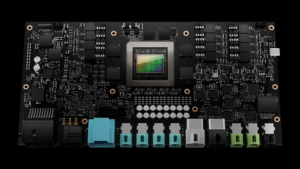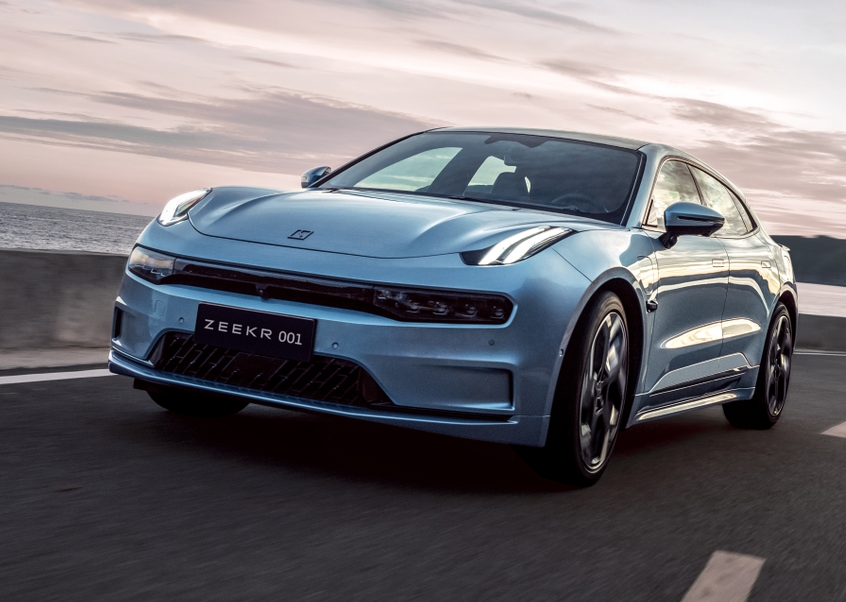Nvidia Assembles Its Next-Gen Centralized Car Computer, ‘DRIVE Thor’

As autonomous vehicles gain more capabilities and more widespread adoption, those vehicles increasingly need powerful edge computing to deliver on their promises. At Nvidia’s fall GTC event today, the company announced its new answer to this need: DRIVE Thor, a centralized car computer for autonomous driving, parking, infotainment, system monitoring and passenger observation. DRIVE Thor replaces DRIVE Atlan (announced last year) in the roadmap and will be the follow-on to DRIVE Orin (currently in production).
Nvidia says that DRIVE Thor wields 2,000 teraflops of FP8 computing power — power that comes courtesy of Nvidia’s Grace CPU and “next-generation” GPU. DRIVE Thor will include an inference transformer engine in its GPU’s Tensor Cores — the first AV platform to come equipped with one — which Nvidia says will allow it to accelerate inference performance by up to 9×, with inference, of course, being a critical workload for self-driving vehicles.
DRIVE Thor — which Nvidia calls a “superchip” — will utilize the NVLink-C2C interconnect and will support multi-domain computing in order to separate the processing of crucial functions like automated driving and functions like infotainment. Nvidia says that DRIVE Thor is capable of simultaneously running Linux, QNX and Android, and that multiple DRIVE Thor chips can be connected via the NVLink-C2C interconnect. However, this kind of partitioning isn’t necessary to take advantage of DRIVE Thor: users can devote all of its computing power to a single function — like autonomous driving — if they so choose.
"The amount of new technology in Thor is insane," said Nvidia CEO Jensen Huang during his GTC keynote today. "Thor centralizes numerous computers and simultaneously offers a leap in capability while reducing cost and power. Today, parking, active safety, driver monitoring, camera mirrors, cluster and infotainment are different computers. In the future, these functions will no longer be separate computers, but will be delivered by software that runs on Thor and improves over time."
“The shift to software-defined vehicles with centralized electronic architectures is accelerating, driving a need for more powerful and more energy-efficient compute platforms,” commented Sam Abuelsamid, principal research analyst at Guidehouse Insights.
That “next-generation” GPU mentioned earlier might have clued you in that DRIVE Thor isn’t coming anytime soon — it’s slated for availability in automakers’ 2025 models, like the DRIVE Atlan that it replaces on the roadmap. ZEEKR, an electric vehicle company owned by Geely, has already announced that DRIVE Thor will be included in its next-generation EVs, which are scheduled for production in early 2025. Nvidia says that ZEEKR will be the first customer for DRIVE Thor.
“ZEEKR users demand a luxury experience that includes the latest technology and safety features,” said ZEEKR CEO An Conghui. “Nvidia DRIVE Thor will support our mission of providing cutting-edge technology that fulfills the needs of our customers and ensures ZEEKR remains at the forefront of tomorrow’s innovations.”
While ZEEKR will be the first, Nvidia also collected a series of supportive comments from other transportation companies — for instance, the autonomous driving company WeRide. “WeRide has high expectations for Nvidia DRIVE Thor, which will deliver the superior compute power we’re seeking for our WeRide One autonomous driving platform,” said Tony Han, WeRide’s CEO and founder. “This is a significant step forward for WeRide in our efforts to deliver a safe and scalable self-driving fleet that spans robotaxis, mini robobuses, robovans and robo-street sweepers.”












